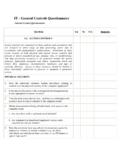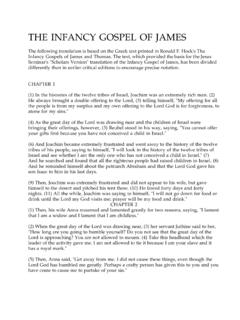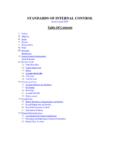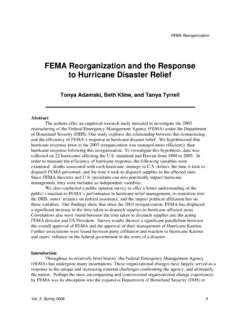Transcription of Services Best Practices Reconciling Payroll Expense
1 financial Services best Practices Reconciling Payroll Expense financial Services policy FIN 203 Org Manager Responsibilities requires that salary and/or wage expenses be reconciled. In order to conform to best Practices for Reconciling Payroll Expense , reconciliations should be completed for every pay period as soon as possible after Payroll expenses have interfaced into Advantage. The reconciliations should be started prior to each pay day with the timely review of the On Cycle Payroll Register Dashboard and completed immediately following each pay day or when the Advantage interface has occurred. Reconciling Payroll includes: 1. Verification of the compensation rate for each employee documented against an offer letter or other source document; 2. Verification that salary/wages paid are correct; 3. Verification employees were paid from the appropriate account; 4.
2 Verification that hours worked and leave time reported are accurate and have been approved by a supervisor; and 5. Verification that Payroll Expense by account tie between PeopleSoft and Advantage. 6. Verify On Cycle Payroll expenses Two Days prior to pay day (for a Friday pay day, the on cycle register is available Wednesday morning). The ASU Dashboards contain Payroll Reconciliation Reports that may be used as a tool in the reconciliation process. Following is a list of Payroll Reconciliation Dashboard Reports: Compensation Rate Report Identifies rate of pay changes between the selected pay period and the prior pay period. Biweekly Payroll Report Provides by pay period salary/wages by employee compared against calculated pay from Job Data. The detail view of this report contains Payroll detail including account distribution. Non Exempt Hours Report Provides time reporting information for hourly employees by pay period on approved hours, hours paid, unapproved hours and standard hours.
3 PeopleSoft to Advantage Reconciliation Provides a monthly reconciliation between PeopleSoft and Advantage Payroll Expense by account. On Cycle Payroll Register The On Cycle Check Register is available two days before pay day. This report lists all employees who will be paid and also compares gross pay, net pay, taxes and deductions for an employee between two consecutive pay periods. Departments can view information by department id, employee id or VP/College. Gross pay can also be shown by earnings code and paid hours. Off Cycle Payroll Register Displays gross pay, net pay, taxes and deductions for off cycle pay periods. Revised: 2/22/12 Page 1 of 13 financial Services best Practices Reconciling Payroll Expense To access the Payroll Reconciliation Reports go to ASU Dashboards. If you currently do not have access to HR My Reports you will need to request access to the Payroll Reconciliation reports.
4 To request access go to the Dashboard main page and click on the Request Access link on the left hand bottom of the page. 1. Verification of Employee Compensation Rate Employees are paid based upon the compensation rate contained in the Job Data screens in PeopleSoft. Departments should confirm that each employee's compensation rate is correct and can be verified against an offer letter, contract or other documentation containing compensation information. For additional information in regards to personnel records refer to SPP 1101 Personnel Records. Revised: 2/22/12 Page 2 of 13 financial Services best Practices Reconciling Payroll Expense The Compensation Rate Report is used to confirm compensation rates for employees. The report is a comparison of the compensation rate and employee status code for the pay period selected against the prior pay period. The first time the report is run, departments should confirm the listed compensation rate against source documentation, such as an offer letter.
5 Once this initial confirmation is made, departments should run the report every pay period and if the CHANGE column is flagged YES , departments should verify that a pay change request was initiated and documentation is in the personnel file to support the change. This report provides Payroll information for on cycle Payroll expenses only; use the PeopleSoft to Advantage report or the Off Cycle Payroll Register to verify off cycle Payroll information. Employee Status codes are: A Active S Suspended R Retired L Leave of Absence W Short Work Break P Leave with Pay T Terminated Revised: 2/22/12 Page 3 of 13 financial Services best Practices Reconciling Payroll Expense After the compensation rate has been confirmed, the amount paid by pay period for each employee should be verified using the Biweekly Payroll Report. 2. Verification of Salary/Wages Paid The Biweekly Payroll Report provides a report of gross pay by employee compared to the calculated pay for the pay period.
6 Report Field Name Definitions: Amount Paid Gross pay from the employee's paycheck. Calculation: o Non Exempt Hourly compensation rate multiplied by paid hours. o Exempt Hourly compensation rate multiplied by standard hours. Additional pay amounts set up through the Additional Pay Module in PeopleSoft are also included in the Calculation field in the Bi Weekly Payroll Report. Any additional pays for an employee are displayed in the Additional Pay Dashboard report. Revised: 2/22/12 Page 4 of 13 financial Services best Practices Reconciling Payroll Expense Paid Hours Total hours reported on the pay check affecting gross pay, including unpaid sick, unpaid vacation, etc. Difference Amount Paid less Calculation. Differences may occur due to unpaid leave, certain pay adjustments created through Payroll , overtime pay, or an error in calculation. Amount Deducted All unpaid leave such as unpaid sick, unpaid vacation, etc.
7 Run the Biweekly Exception Detail Report by selecting Exception Details from the View Report Type Drop Down Box. View the exception details and research and reconcile all differences. If an overpayment is found, it must be promptly reported to Payroll Services . Departments are not authorized to overlook or forgive any overpayment. Please refer to FIN 602: Wage/Salary Overpayment Responsibilities, for details of the policy. Overpayment activity cannot remain on a sponsored account unless repayment occurs immediately. If the repayment does not occur immediately upon discovery of the overpayment, departments are to prepare a Payroll Expense Redistribution Entry in PeopleSoft to transfer the overpayment amount to a local account. If you have questions regarding this process contact effort Revised: 2/22/12 Page 5 of 13 financial Services best Practices Reconciling Payroll Expense Repayments of overpayments will post to the current account mapping of the position number the overpayment occurred on, in most cases this will be the original account the overpayment occurred on.
8 If the department redistributed the overpayment they may be required to process an additional Payroll Expense Redistribution Entry to correctly record the repayment and overpayment on the same account. Refer to the Commitment Accounting website for instructions on preparing a Payroll Expense Redistribution Entry. 3. Verification Employees were Paid from Correct Account Use the Biweekly Payroll Report to verify account information. From the View Drop Down list select Details to retrieve a listing of the Payroll detail including account distribution. Revised: 2/22/12 Page 6 of 13 financial Services best Practices Reconciling Payroll Expense Detail View Biweekly Payroll Verification Report Verify the account charged is correct. Revised: 2/22/12 Page 7 of 13 financial Services best Practices Reconciling Payroll Expense 4. Verification of Time Reported Supervisors are required to verify and approve reported time.
9 The approval of time in PeopleSoft is performed by a Department Time Administrator (DTA). If the DTA is the supervisor, PeopleSoft will be the system of record for supervisor approval of timesheets. If the DTA is not the supervisor, departments are required to verify the hours entered and approved in PeopleSoft match the supervisor approved timesheets. Departments must also maintain documentation of supervisor approved time sheets. The Non Exempt Hours Report provides time sheet information for hourly employees. Revised: 2/22/12 Page 8 of 13 financial Services best Practices Reconciling Payroll Expense Report Field Name Definitions: Standard Hours is from the employee job record in PeopleSoft. Recorded Hours are the hours entered into the PeopleSoft timesheets. Not Approved/Denied are hours that were entered into PeopleSoft timesheets and not approved or denied by the DTA.
10 Approved Hours are the hours approved by the DTA. The hours in Not Approved/Denied and Approved reflect the current approval status and may not be the status during the pay period. Paid Hours are the total hours reported on the pay check affecting gross pay; including unpaid sick, unpaid vacation, etc. Difference is Paid Hours less Approved Hours. Differences may occur due to compensatory time earned for non exempt employees working more than 40 hours per week, vacation and comp time pay outs and other Payroll adjustments. To run a report of Differences click on the Show/Hide Exceptions Details button. In the above example, there are no employees in this department code that had a difference between approved hours and paid hours for this pay period. Revised: 2/22/12 Page 9 of 13 financial Services best Practices Reconciling Payroll Expense If a difference is present, click on the Empl ID field to display details regarding the amount paid.









